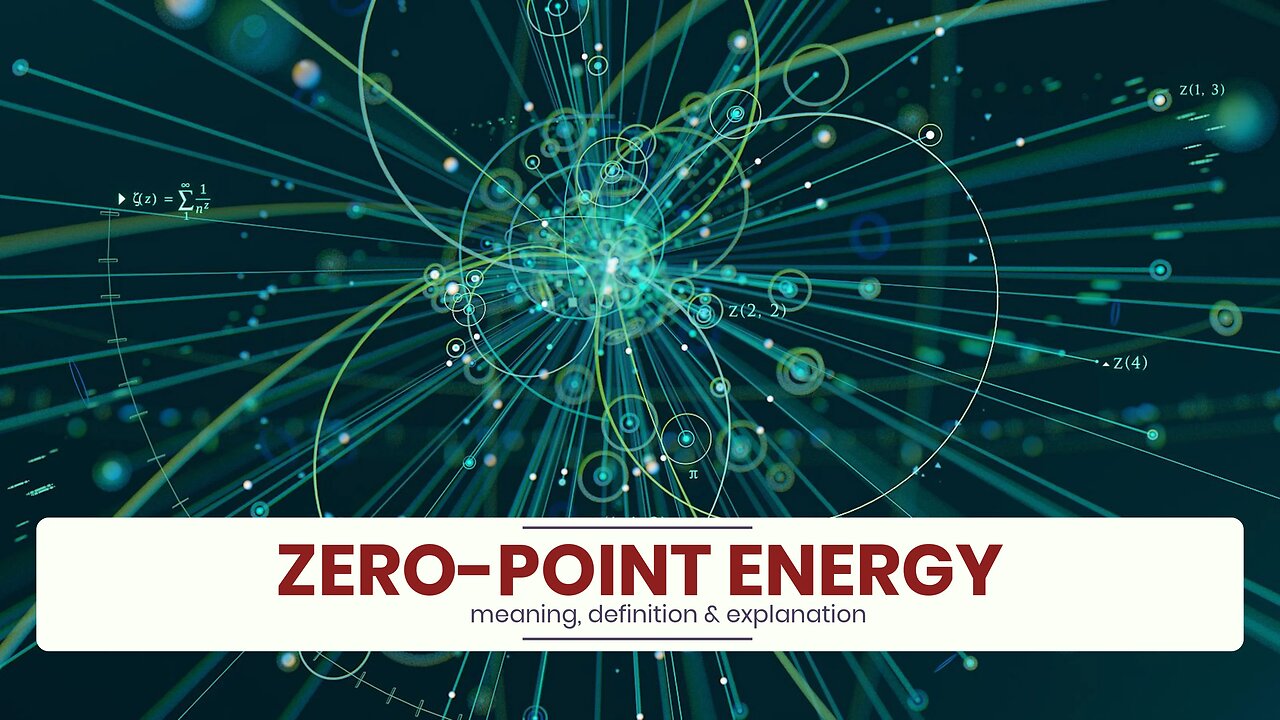Premium Only Content

What is ZERO-POINT ENERGY?
✪✪✪✪✪
http://www.theaudiopedia.com
✪✪✪✪✪
What does ZERO-POINT ENERGY mean? ZERO-POINT ENERGY meaning - ZERO-POINT ENERGY definition - ZERO-POINT ENERGY explanation. What is the meaning of ZERO-POINT ENERGY? What is the definition of ZERO-POINT ENERGY? What does ZERO-POINT ENERGY stand for? What is ZERO-POINT ENERGY meaning? What is ZERO-POINT ENERGY definition?
Zero-point energy, also called quantum vacuum zero-point energy, is the lowest possible energy that a quantum mechanical physical system may have; it is the energy of its ground state.
All quantum mechanical systems undergo fluctuations even in their ground state and have an associated zero-point energy, a consequence of their wave-like nature. The uncertainty principle requires every physical system to have a zero-point energy greater than the minimum of its classical potential well. This results in motion even at absolute zero. For example, liquid helium does not freeze under atmospheric pressure at any temperature because of its zero-point energy.
The concept of zero-point energy was developed by Max Planck in Germany in 1911 as a corrective term added to a zero-grounded formula developed in his original quantum theory in 1900. The term zero-point energy is a translation from the German Nullpunktsenergie.:275ff
Vacuum energy is the zero-point energy of all the fields in space, which in the Standard Model includes the electromagnetic field, other gauge fields, fermionic fields, and the Higgs field. It is the energy of the vacuum, which in quantum field theory is defined not as empty space but as the ground state of the fields. In cosmology, the vacuum energy is one possible explanation for the cosmological constant. A related term is zero-point field, which is the lowest energy state of a particular field.
Scientists are not in agreement about how much energy is contained in the vacuum. Quantum mechanics requires the energy to be large as Paul Dirac claimed it is, like a sea of energy. Other scientists specializing in General Relativity require the energy to be small enough for curvature of space to agree with observed astronomy. The Heisenberg uncertainty principle allows the energy to be as large as needed to promote quantum actions for a brief moment of time, even if the average energy is small enough to satisfy relativity and flat space. To cope with disagreements, the vacuum energy is described as a virtual energy potential of positive and negative energy.
As a scientific concept, the existence of zero-point energy is not controversial. However, the ability to harness zero point energy for useful work is considered pseudoscience by the scientific community at large. Zero-point energy is, by definition, a minimum energy below which a thermodynamic system can never go. Thus, none of this energy can be withdrawn without altering the system to a different form in which the system has a lower zero-point energy. Nevertheless, there have been numerous claims of devices capable of extracting usable zero-point energy. None of these claims has ever been validated by the scientific community.
Science skeptic and writer Martin Gardner has called claims of such zero-point-energy-based systems "as hopeless as past efforts to build perpetual motion machines". A perpetual motion machine is a device that can operate indefinitely, with optional output of excess energy, without any source of fuel. Such a device would violate the laws of thermodynamics. Despite the science, numerous articles and books have been published addressing and discussing the potential of tapping zero-point-energy from the quantum vacuum or elsewhere. Examples of such are the work of the following authors: Claus Wilhelm Turtur, Jeane Manning, Joel Garbon, John Bedini, Tom Bearden, Thomas Valone, Moray B King, Christopher Toussaint, Bill Jenkins, Nick Cook and William James.
The calculation that underlies the Casimir experiment, a calculation based on the formula predicting infinite vacuum energy, shows the zero-point energy of a system consisting of a vacuum between two plates will decrease at a finite rate as the two plates are drawn together. The vacuum energies are predicted to be infinite, but the changes are predicted to be finite. Casimir combined the projected rate of change in zero-point energy with the principle of conservation of energy to predict a force on the plates. The predicted force, which is very small and was experimentally measured to be within 5% of its predicted value, is finite. Even though the zero-point energy is theoretically infinite, there is no evidence to suggest that infinite amounts of zero-point energy are available for use
-
 2:24
2:24
The Audiopedia
1 year agoWhat is AUSTERITY?
90 -
 LIVE
LIVE
TheItalianCEO
4 hours agoLast stream before Dreamhack
103 watching -
 LIVE
LIVE
Cripiechuccles
1 hour ago😁18+💚💙SUNDAY FUNDAY WITH CRIPIE💚RUMLUV💙👌SMOKING, GAMING & WATCHING FLICKS!:😁
28 watching -
 LIVE
LIVE
DoldrumDan
1 hour agoSACRED SEKIRO DAY 6 FIRST PLAYTHROUGH - DAY 24 NEW LIFE
17 watching -
 LIVE
LIVE
Total Horse Channel
7 hours ago2025 IRCHA Derby & Horse Show - October 26th
100 watching -
 4:23:33
4:23:33
BBQPenguin_
7 hours agoBattlefield 6 - Battle Royale Waiting Room
16.3K -
 13:49
13:49
Clintonjaws
22 hours ago $54.94 earnedWOW Trump Just Said He's Doing This To Canada
58.4K85 -
 3:40:40
3:40:40
EXPBLESS
7 hours agoWAKE UP WITH BLESS WE GAMIN SON 🫡
16.8K1 -
 2:04:59
2:04:59
LFA TV
2 days agoTHE RUMBLE RUNDOWN LIVE @9AM EST
83.7K24 -
 5:35:18
5:35:18
MrR4ger
8 hours agoDEMONS VS ANGELS - THE BORNLESS W/ TONYGAMING (LILSHAWTYSTREAM)
18.6K